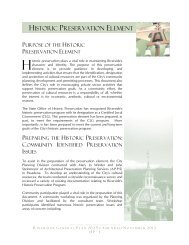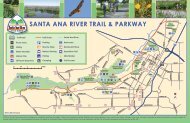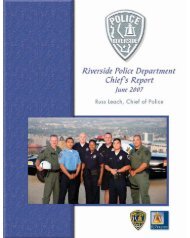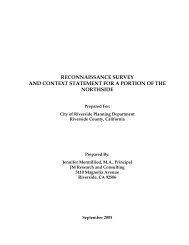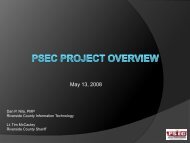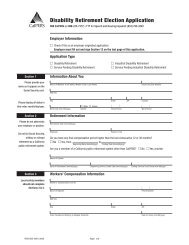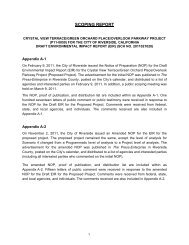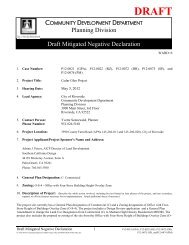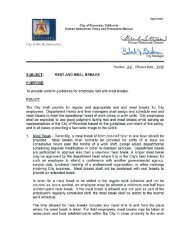Airport Master Plan - City of Riverside
Airport Master Plan - City of Riverside
Airport Master Plan - City of Riverside
Create successful ePaper yourself
Turn your PDF publications into a flip-book with our unique Google optimized e-Paper software.
AREA LAND USE<br />
Land uses in the vicinity <strong>of</strong> the airport<br />
can have a significant impact on airport<br />
operations and growth. The following<br />
section identifies baseline information<br />
relating to both existing and<br />
future land uses in the vicinity <strong>of</strong> <strong>Riverside</strong><br />
<strong>Airport</strong>. By understanding the<br />
land use issues surrounding the airport,<br />
more appropriate recommendations<br />
can be made for the future <strong>of</strong> the<br />
airport.<br />
Land use in the vicinity <strong>of</strong> the airport<br />
is a mixture <strong>of</strong> residential, commercial,<br />
industrial, and open space. To<br />
the north <strong>of</strong> the airport is a mixture <strong>of</strong><br />
industrial and open space land uses<br />
extending to the Santa Ana River valley.<br />
Land uses to the south, west, and<br />
east are primarily residential. A<br />
number <strong>of</strong> schools, churches, healthcare,<br />
and commercial facilities are distributed<br />
through these residential<br />
areas. Exhibit 1B presents existing<br />
land uses in the vicinity <strong>of</strong> the airport.<br />
Exhibit 1C presents the current land<br />
use policy for properties in the vicinity<br />
<strong>of</strong> the airport. This land use policy is<br />
included in the <strong>City</strong> <strong>of</strong> <strong>Riverside</strong> General<br />
<strong>Plan</strong> as adopted in 2006.<br />
Height restrictions are necessary to<br />
ensure that objects will not impair<br />
flight safety or decrease the operational<br />
capability <strong>of</strong> the airport. Title<br />
14 <strong>of</strong> the Code <strong>of</strong> Federal Regulations<br />
(CFR) Part 77, Objects Affecting Navigable<br />
Airspace, defines a series <strong>of</strong><br />
imaginary surfaces surrounding airports.<br />
The imaginary surfaces consist<br />
<strong>of</strong> the approach zone, conical zones,<br />
transitional zones, and horizontal<br />
zones. Objects such as trees, towers,<br />
buildings, or roads, which penetrate<br />
any <strong>of</strong> these surfaces, are considered<br />
by the FAA to be an obstruction to air<br />
navigation. Current <strong>City</strong> <strong>of</strong> <strong>Riverside</strong><br />
ordinances adhere to and support the<br />
height restriction guidelines as set<br />
forth in 14 CFR Part 77. Height restrictions<br />
can be accomplished through<br />
height and hazard zoning, avigation<br />
easements, or fee simple acquisition.<br />
RIVERSIDE COUNTY<br />
AIRPORT LAND USE<br />
COMPATIBILITY PLAN<br />
<strong>Airport</strong> land use commissions<br />
(ALUCs) were first established under<br />
the California State Aeronautics Act in<br />
1967. Although the law has been<br />
amended numerous times since then,<br />
the fundamental purpose <strong>of</strong> ALUCs to<br />
promote land use compatibility around<br />
airports has remained unchanged.<br />
The statute gives ALUCs two principal<br />
powers by which to accomplish this<br />
objective. First, ALUCs must prepare<br />
and adopt an airport land use compatibility<br />
plan. Secondly, they must review<br />
the plans, regulations, and other<br />
actions <strong>of</strong> local agencies and airport<br />
operators for consistency with that<br />
plan.<br />
The ALUCs are somewhat limited in<br />
their enforcement power. The statute<br />
specifically says that ALUCs have no<br />
authority over either existing land<br />
uses or the operation <strong>of</strong> airports. Local<br />
general plans are the primary mechanism<br />
for implementing the compatibility<br />
policies set forth in the ALUCs<br />
plan.<br />
1-4



